Showing Spotlights 2585 - 2592 of 2851 in category All (newest first):
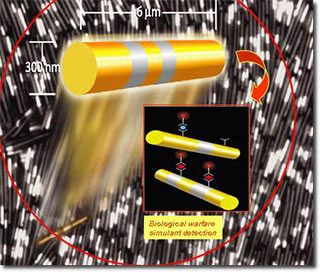 In an effort to detect biological threats quickly and accurately, a number of detection technologies have been developed. This rapid growth and development in biodetection technology has largely been driven by the emergence of new and deadly infectious diseases and the realization of biological warfare as new means of terrorism. To address the need for portable, multiplex biodetection systems a number of immunoassays have been developed. An immunoassay is a biochemical test that measures the level of a substance in a biological liquid. The assay takes advantage of the specific binding of an antigen to its antibody, the proteins that the body produces to directly attack, or direct the immune system to attack, cells that have been infected by viruses, bacteria and other intruders. Physical, chemical and optical properties that can be tuned to detect a particular bioagent are key to microbead-based immunoassay sensing systems. A unique spectral signature or fingerprint can be tied to each type of bead. Beads can be joined with antibodies to specific biowarfare agents. A recently developed novel biosensing platform uses engineered nanowires as an alternative substrate for immunoassays. Nanowires built from sub-micrometer layers of different metals, including gold, silver and nickel, are able to act as "barcodes" for detecting a variety of pathogens, such as anthrax, smallpox, ricin and botulinum toxin. The approach could simultaneously identify multiple pathogens via their unique fluorescent characteristics.
In an effort to detect biological threats quickly and accurately, a number of detection technologies have been developed. This rapid growth and development in biodetection technology has largely been driven by the emergence of new and deadly infectious diseases and the realization of biological warfare as new means of terrorism. To address the need for portable, multiplex biodetection systems a number of immunoassays have been developed. An immunoassay is a biochemical test that measures the level of a substance in a biological liquid. The assay takes advantage of the specific binding of an antigen to its antibody, the proteins that the body produces to directly attack, or direct the immune system to attack, cells that have been infected by viruses, bacteria and other intruders. Physical, chemical and optical properties that can be tuned to detect a particular bioagent are key to microbead-based immunoassay sensing systems. A unique spectral signature or fingerprint can be tied to each type of bead. Beads can be joined with antibodies to specific biowarfare agents. A recently developed novel biosensing platform uses engineered nanowires as an alternative substrate for immunoassays. Nanowires built from sub-micrometer layers of different metals, including gold, silver and nickel, are able to act as "barcodes" for detecting a variety of pathogens, such as anthrax, smallpox, ricin and botulinum toxin. The approach could simultaneously identify multiple pathogens via their unique fluorescent characteristics.
Mar 8th, 2007
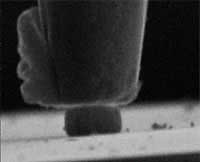 The earliest forgings, appearing around 1600 BC, were crudely hammered ornaments from naturally occurring free metals. The latest, most state-of-the-art forging techniques use micron-sized hammers to forge nanometer-sized metal shapes to be used as components in nanotechnology and microtechnology systems. New research demonstrates the possibilities of nanoforging - applying conventional metal shaping techniques to nano objects. In recent years, nanoscale fabrication has developed considerably, but the fabrication of free-standing nanosize components is still a great challenge. The ability to produce high-strength metallic components with characteristic dimensions of nanometers by nanoforging opens up new possibilities to eventually produce complex microsystems by assembling free-standing nanoscopic components. At these sizes they are of the same dimensions as micro-organisms and therefore sufficiently small even to travel through the human body.
The earliest forgings, appearing around 1600 BC, were crudely hammered ornaments from naturally occurring free metals. The latest, most state-of-the-art forging techniques use micron-sized hammers to forge nanometer-sized metal shapes to be used as components in nanotechnology and microtechnology systems. New research demonstrates the possibilities of nanoforging - applying conventional metal shaping techniques to nano objects. In recent years, nanoscale fabrication has developed considerably, but the fabrication of free-standing nanosize components is still a great challenge. The ability to produce high-strength metallic components with characteristic dimensions of nanometers by nanoforging opens up new possibilities to eventually produce complex microsystems by assembling free-standing nanoscopic components. At these sizes they are of the same dimensions as micro-organisms and therefore sufficiently small even to travel through the human body.
Mar 7th, 2007
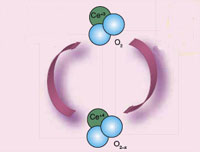 Can a major component of a catalytic converter or a fullerene derivative lead to an eventual treatment for Parkinson's disease or arthritis? Research to date certainly hints at this possibility. In chemistry, radicals (often referred to as free radicals) are atomic or molecular species with unpaired electrons on an otherwise open shell configuration. These unpaired electrons are usually highly reactive, so radicals are likely to take part in chemical reactions. Radicals play an important role in human physiology but, because of their reactivity, they also can can participate in unwanted side reactions resulting in cell damage. Free radicals damage components of the cells' membranes, proteins or genetic material by "oxidizing" them - the same chemical reaction that causes iron to rust. This is called "oxidative stress". Many forms of cancer are thought to be the result of reactions between free radicals and DNA, resulting in mutations that can adversely affect the cell cycle and potentially lead to malignancy. Oxidative stress is believed to play a role in neurodegenerative diseases such as Alzheimer's and Parkinson's.Some of the symptoms of aging such as arteriosclerosis are also attributed to free-radical induced oxidation of many of the chemicals making up the body. Despite the broad role that oxidative stress plays in human disease, medicine has been limited in its development of treatments that counteract free radical damage and the ensuing burden of oxidative stress. In contrast, in the field of engineering, considerable effort has been developed to counter the effects of oxidative stress at the materials science level. Nanotechnology has provided numerous constructs that reduce oxidative damage in engineering applications with great efficiency. A recent review looks at how these nanoengineering concepts could be applied to biomedical problems, ultimately leading to nanotechnology-based therapeutical treatments for oxidative stress-induced diseases.
Can a major component of a catalytic converter or a fullerene derivative lead to an eventual treatment for Parkinson's disease or arthritis? Research to date certainly hints at this possibility. In chemistry, radicals (often referred to as free radicals) are atomic or molecular species with unpaired electrons on an otherwise open shell configuration. These unpaired electrons are usually highly reactive, so radicals are likely to take part in chemical reactions. Radicals play an important role in human physiology but, because of their reactivity, they also can can participate in unwanted side reactions resulting in cell damage. Free radicals damage components of the cells' membranes, proteins or genetic material by "oxidizing" them - the same chemical reaction that causes iron to rust. This is called "oxidative stress". Many forms of cancer are thought to be the result of reactions between free radicals and DNA, resulting in mutations that can adversely affect the cell cycle and potentially lead to malignancy. Oxidative stress is believed to play a role in neurodegenerative diseases such as Alzheimer's and Parkinson's.Some of the symptoms of aging such as arteriosclerosis are also attributed to free-radical induced oxidation of many of the chemicals making up the body. Despite the broad role that oxidative stress plays in human disease, medicine has been limited in its development of treatments that counteract free radical damage and the ensuing burden of oxidative stress. In contrast, in the field of engineering, considerable effort has been developed to counter the effects of oxidative stress at the materials science level. Nanotechnology has provided numerous constructs that reduce oxidative damage in engineering applications with great efficiency. A recent review looks at how these nanoengineering concepts could be applied to biomedical problems, ultimately leading to nanotechnology-based therapeutical treatments for oxidative stress-induced diseases.
Mar 6th, 2007
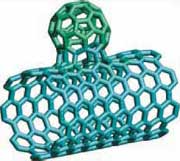 Carbon comes in many different forms, from the graphite found in pencils to the world's most expensive diamonds. While diamonds might be very popular among ladies, the two most celebrated carbon materials among nanotechnology scientists are fullerenes and carbon nanotubes. What makes them so interesting are the many advantageous properties that they exhibit. Despite the similarities between these two forms of carbon, there have been very few attempts to physically merge them. An international research group, led by a Finnish team, now has discovered a novel hybrid material that combines fullerenes and single-walled carbon nanotubes (SWCNTs) into a single structure in which the fullerenes are covalently bonded to the outer surface of the SWCNTs. In this newly discovered material, that the researchers termed NanoBuds, the fullerene molecules are attached to the outside surface of the carbon nanotubes, just like buds on the branch of a tree - hence the name - and can be made in a simple one-step process. These NanoBuds have been shown to be extremely efficient electron emitters and have excellent electrical conductive properties. In fact, as NanoBuds combine the chemical reactivity of fullerenes and electrical, optical as well as mechanical properties of carbon nanotubes, they may one day replace current materials in many products. Research is continuing to explore NanoBuds' properties with a view to using them in a wide range of applications.
Carbon comes in many different forms, from the graphite found in pencils to the world's most expensive diamonds. While diamonds might be very popular among ladies, the two most celebrated carbon materials among nanotechnology scientists are fullerenes and carbon nanotubes. What makes them so interesting are the many advantageous properties that they exhibit. Despite the similarities between these two forms of carbon, there have been very few attempts to physically merge them. An international research group, led by a Finnish team, now has discovered a novel hybrid material that combines fullerenes and single-walled carbon nanotubes (SWCNTs) into a single structure in which the fullerenes are covalently bonded to the outer surface of the SWCNTs. In this newly discovered material, that the researchers termed NanoBuds, the fullerene molecules are attached to the outside surface of the carbon nanotubes, just like buds on the branch of a tree - hence the name - and can be made in a simple one-step process. These NanoBuds have been shown to be extremely efficient electron emitters and have excellent electrical conductive properties. In fact, as NanoBuds combine the chemical reactivity of fullerenes and electrical, optical as well as mechanical properties of carbon nanotubes, they may one day replace current materials in many products. Research is continuing to explore NanoBuds' properties with a view to using them in a wide range of applications.
Mar 5th, 2007
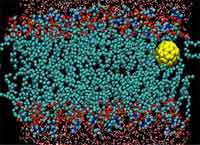 Obtaining an understanding, at the atomic level, of the interaction of nanomaterials with biological systems has recently become an issue of great research interest. Nanomaterials can exhibit drastically different characteristics compared to their bulk counterparts. Although the use of such materials in biological systems opens avenues for the creation of novel biosensing and alternative nanomedical technologies, these nanomaterials can also be highly toxic. A greater understanding of the interaction of nanomaterials with biological systems, especially of the interaction of nanomaterials with cell membranes, will enable scientists to take full advantage of the unique properties of nanomaterials while minimizing their adverse effects. Fullerenes and their derivatives are an important subset of nanomaterials. Fullerenes have been used as robust oxygen scavengers, anti-HIV drugs, X-ray contrast agents, and transporters for delivering antibodies. While experimental studies suggest that the toxicity of nanomaterials depends critically on their surface properties, it was also found that, in the case of fullerenes, functionalizing the molecules can reduce their toxicity notably. New work by U.S. researchers offers a mechanistic view on the different cytotoxicity of fullerenes and their functionalized derivatives - a first in this important field of nanotoxicity. The major finding is that pristine fullerene can readily jump into a lipid bilayer while the translocation of a functionalized fullerene is severely hindered due to its surface charge, leading to a much reduced toxicity.
Obtaining an understanding, at the atomic level, of the interaction of nanomaterials with biological systems has recently become an issue of great research interest. Nanomaterials can exhibit drastically different characteristics compared to their bulk counterparts. Although the use of such materials in biological systems opens avenues for the creation of novel biosensing and alternative nanomedical technologies, these nanomaterials can also be highly toxic. A greater understanding of the interaction of nanomaterials with biological systems, especially of the interaction of nanomaterials with cell membranes, will enable scientists to take full advantage of the unique properties of nanomaterials while minimizing their adverse effects. Fullerenes and their derivatives are an important subset of nanomaterials. Fullerenes have been used as robust oxygen scavengers, anti-HIV drugs, X-ray contrast agents, and transporters for delivering antibodies. While experimental studies suggest that the toxicity of nanomaterials depends critically on their surface properties, it was also found that, in the case of fullerenes, functionalizing the molecules can reduce their toxicity notably. New work by U.S. researchers offers a mechanistic view on the different cytotoxicity of fullerenes and their functionalized derivatives - a first in this important field of nanotoxicity. The major finding is that pristine fullerene can readily jump into a lipid bilayer while the translocation of a functionalized fullerene is severely hindered due to its surface charge, leading to a much reduced toxicity.
Mar 2nd, 2007
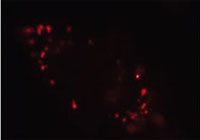 Fluorescent semiconductor nanocrystals (or quantum dots) hold a number of advantageous features including high photobleaching thresholds and broad excitation but narrow emission spectra well suited for multicolor labeling and detection. Unfortunately, most quantum dots are toxic, and hence reduction of cytotoxicity and human toxicity through surface modification plays a pivotal role in their successful application to in vivo labeling, imaging, and diagnosis. Researchers now have demonstrated that nanodiamond particles possess several unique features, including facile surface modification, long-term photostability, and no fluorescence blinking, that makes their detection and long-term tracking in living cells not only possible but practical.
Fluorescent semiconductor nanocrystals (or quantum dots) hold a number of advantageous features including high photobleaching thresholds and broad excitation but narrow emission spectra well suited for multicolor labeling and detection. Unfortunately, most quantum dots are toxic, and hence reduction of cytotoxicity and human toxicity through surface modification plays a pivotal role in their successful application to in vivo labeling, imaging, and diagnosis. Researchers now have demonstrated that nanodiamond particles possess several unique features, including facile surface modification, long-term photostability, and no fluorescence blinking, that makes their detection and long-term tracking in living cells not only possible but practical.
Mar 1st, 2007
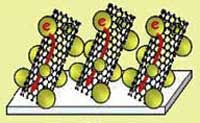 The photocatalytic activity of nanostructured semiconductor films has been widely explored in designing solar cells, solar hydrogen production, and environmental remediation. Of particular interest is the dye-sensitized solar cell (DSSC) which uses nanostructured titanium dioxide films modified with sensitizing dyes. Despite the initial success of achieving 10% solar conversion efficiency, the effort to further improve their performance has not been very successful. A major hurdle in attaining higher photoconversion efficiency in such nanostructured electrodes is the transport of electrons across the particle network. The photogenerated electrons in nanostructured films for example have to travel through the network of semiconductor particles and encounter many grain boundaries during the transit. Such a random transit path for the photogenerated electrons increases the probability of their recombination with oxidized sensitizer. With the recent advance in the design of nanotube and nanowire architecture, it should be possible to use such one-dimensional nanostructures to direct the flow of photogenerated charge carriers. The obvious challenge is to use nanowire or nanotube networks as support to anchor light-harvesting semiconductor particles and facilitate the electron transport to the collecting electrode surface in a solar cell. Researchers now have demonstrated that single wall carbon nanotube (SWCNT) architecture when employed as conducting scaffolds in a titanium dioxide semiconductor based photoelectrochemical cell can boost the photoconversion efficiency by a factor of 2.
The photocatalytic activity of nanostructured semiconductor films has been widely explored in designing solar cells, solar hydrogen production, and environmental remediation. Of particular interest is the dye-sensitized solar cell (DSSC) which uses nanostructured titanium dioxide films modified with sensitizing dyes. Despite the initial success of achieving 10% solar conversion efficiency, the effort to further improve their performance has not been very successful. A major hurdle in attaining higher photoconversion efficiency in such nanostructured electrodes is the transport of electrons across the particle network. The photogenerated electrons in nanostructured films for example have to travel through the network of semiconductor particles and encounter many grain boundaries during the transit. Such a random transit path for the photogenerated electrons increases the probability of their recombination with oxidized sensitizer. With the recent advance in the design of nanotube and nanowire architecture, it should be possible to use such one-dimensional nanostructures to direct the flow of photogenerated charge carriers. The obvious challenge is to use nanowire or nanotube networks as support to anchor light-harvesting semiconductor particles and facilitate the electron transport to the collecting electrode surface in a solar cell. Researchers now have demonstrated that single wall carbon nanotube (SWCNT) architecture when employed as conducting scaffolds in a titanium dioxide semiconductor based photoelectrochemical cell can boost the photoconversion efficiency by a factor of 2.
Feb 28th, 2007
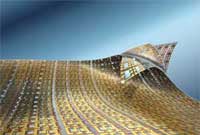 Nanoelectronics devices often are made by integrating dissimilar classes of semiconductors and various other disparate materials into one heterogeneous single system. The two primary modes of combining these materials - mechanical bonding and epitaxial growth processes - place stringent requirements on the ultimate scale or constituent materials of circuits. With mechanical bonding, there is a limited ability to scale to large areas (i.e., larger than the wafers) or to more than a few stacking layers; incompatibility with unusual materials (such as nanostructured materials) and/or low-temperature materials and substrates; challenging fabrication and alignment for the through-wafer electrical interconnects; demanding requirements for planar bonding surfaces; and bowing and cracking that can occur from mechanical strains generated by differential thermal expansion and contraction of disparate materials. Epitaxy avoids some of these problems but places severe restrictions on the quality and type of materials that can be grown. Using a process akin to the printing press, researchers have managed to bypass the need for epitaxial growth or wafer bonding to integrate wide ranging classes of dissimilar semiconducting nanomaterials onto substrates for the purpose of constructing heterogeneous, three dimensional electronics.
Nanoelectronics devices often are made by integrating dissimilar classes of semiconductors and various other disparate materials into one heterogeneous single system. The two primary modes of combining these materials - mechanical bonding and epitaxial growth processes - place stringent requirements on the ultimate scale or constituent materials of circuits. With mechanical bonding, there is a limited ability to scale to large areas (i.e., larger than the wafers) or to more than a few stacking layers; incompatibility with unusual materials (such as nanostructured materials) and/or low-temperature materials and substrates; challenging fabrication and alignment for the through-wafer electrical interconnects; demanding requirements for planar bonding surfaces; and bowing and cracking that can occur from mechanical strains generated by differential thermal expansion and contraction of disparate materials. Epitaxy avoids some of these problems but places severe restrictions on the quality and type of materials that can be grown. Using a process akin to the printing press, researchers have managed to bypass the need for epitaxial growth or wafer bonding to integrate wide ranging classes of dissimilar semiconducting nanomaterials onto substrates for the purpose of constructing heterogeneous, three dimensional electronics.
Feb 27th, 2007
 In an effort to detect biological threats quickly and accurately, a number of detection technologies have been developed. This rapid growth and development in biodetection technology has largely been driven by the emergence of new and deadly infectious diseases and the realization of biological warfare as new means of terrorism. To address the need for portable, multiplex biodetection systems a number of immunoassays have been developed. An immunoassay is a biochemical test that measures the level of a substance in a biological liquid. The assay takes advantage of the specific binding of an antigen to its antibody, the proteins that the body produces to directly attack, or direct the immune system to attack, cells that have been infected by viruses, bacteria and other intruders. Physical, chemical and optical properties that can be tuned to detect a particular bioagent are key to microbead-based immunoassay sensing systems. A unique spectral signature or fingerprint can be tied to each type of bead. Beads can be joined with antibodies to specific biowarfare agents. A recently developed novel biosensing platform uses engineered nanowires as an alternative substrate for immunoassays. Nanowires built from sub-micrometer layers of different metals, including gold, silver and nickel, are able to act as "barcodes" for detecting a variety of pathogens, such as anthrax, smallpox, ricin and botulinum toxin. The approach could simultaneously identify multiple pathogens via their unique fluorescent characteristics.
In an effort to detect biological threats quickly and accurately, a number of detection technologies have been developed. This rapid growth and development in biodetection technology has largely been driven by the emergence of new and deadly infectious diseases and the realization of biological warfare as new means of terrorism. To address the need for portable, multiplex biodetection systems a number of immunoassays have been developed. An immunoassay is a biochemical test that measures the level of a substance in a biological liquid. The assay takes advantage of the specific binding of an antigen to its antibody, the proteins that the body produces to directly attack, or direct the immune system to attack, cells that have been infected by viruses, bacteria and other intruders. Physical, chemical and optical properties that can be tuned to detect a particular bioagent are key to microbead-based immunoassay sensing systems. A unique spectral signature or fingerprint can be tied to each type of bead. Beads can be joined with antibodies to specific biowarfare agents. A recently developed novel biosensing platform uses engineered nanowires as an alternative substrate for immunoassays. Nanowires built from sub-micrometer layers of different metals, including gold, silver and nickel, are able to act as "barcodes" for detecting a variety of pathogens, such as anthrax, smallpox, ricin and botulinum toxin. The approach could simultaneously identify multiple pathogens via their unique fluorescent characteristics.
 Subscribe to our Nanotechnology Spotlight feed
Subscribe to our Nanotechnology Spotlight feed





